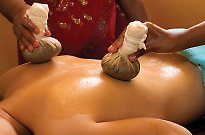
Ayurvedic Applications for health and harmony

In part two of our introduction to Ayurveda, Diana Timmins tells us what floats our dosha boat…and what sends it sinking.
It is inevitable that we may be a little ‘out of sorts’, lose our sense of grounding or be knocked off our perch from time to time. But are our actions pacifying or aggravating the situation? According to the ancient Eastern healing principles of Ayurveda, which translates to ‘knowledge of life’, our lifestyle choices not only affect our ability to remain balanced on shaky ground, but could in fact be the initial cause for such physical and psychological disharmony.
Great Ayurvedic scholar, Maharishi Charak, once explained Ayurveda as making people “aware about their lifestyle, diet, exercise and mental activities to achieve perfect balance in mind, body and soul.” A completely holistic system, Ayurveda works on the premise that each individual is unique in terms of his or her ‘constitution’ or elemental make-up, known in Sanskrit as ‘prikriti’, and therefore provides therapeutic tools specifically suited to individual needs.
AYURVEDA AT A GLANCE
Key points from our introduction:
- The same five elements that make up the universe – ether, air, fire, water and earth – also make up the human physiology (elemental body type), and how these are balanced, or unbalanced, ultimately impacts our experience of life.
- The five elements also create three ‘forces’ or ‘psychophysiological energies’ in the body, which Ayurveda refers to as doshas: vata (earth and air), pitta (fire and water) and kapha (water and earth).
- Occasionally, people may have equal proportions of each dosha or one prevailing. However, most will generally have two fairly equal and one substantially less lively in their nature.
- Head to www.whatsyourdosha.com and take the online quiz to discover your dominant dosha.
- World renowned Ayurvedic doctor, Rama Prasad, believes any modification of our elemental body type indicates an imbalance, which can be rebalanced by any number of Ayurvedic applications, particularly suitable lifestyle choices. An imbalance, or vikriti, is a physical or psychological excess that Dr Rama Prasad believes is often due to overuse, underuse or abuse of the elements of life.
RECTIFYING IMBALANCES
VATA
Yogacharya warns that vata in excess often causes dryness of skin and membranes, as well as emaciation, debility, desire for warmth, tremors, constipation, insomnia, sensory disorientation, incoherent speech, dizziness and depression.
Diet Dos and Don’ts:
- Emphasise sweet, sour and salty tastes
- Make sure food is warm, moist and well lubricated, for example, soups, hot drinks, rice with ghee or oil
- Avoid cold or frozen food and drinks
- Minimise raw foods, especially apples
- Go easy on most beans
“Keep warm and to a regular routine. And create a calm, safe and secure environment for yourself,” advises Yogacharya.
Essential Oils: Musk, lemon, lemongrass
Colours: gentle, warm colours like yellow, orange, white
Gems: emerald, jade, yellow sapphire, topaz, citrine, garnet, ruby and peridot.
PITTA
Yogacharya Michael, founder of International Yogalam, says high pitta results in accumulation of internal heat or fever, with inflammations and infection occurring. “Pitta in excess causes yellow colouring of stools, urine, eyes and skin, as well as hunger, heartburn and difficulty sleeping.”
Diet Dos and Don’ts:
- Emphasise sweet, bitter and astringent tastes
- Avoid oils, fried foods, caffeine, salt, alcohol, red meat and hot spices
- Emphasise fresh fruits and vegetables
- Get ample milk and wholegrains
In addition, Yogacharya recommends getting plenty of fresh air, and avoiding excess heat, steam and humidity. And just as importantly – trust and express your feelings.
Essential Oils: sandalwood, lavender, jasmine, rose, vetiver, henna, lotus, gardenia, iris and peppermint
Colours: gentle and cooling colours, like blue, green, white and pastel colours
Gems: emerald, amethyst, jade, blue sapphire, topaz, citrine, garnet and rose quartz
KAPHA
According to Yogacharya, kapha in excess causes depression of the digestive fire, nausea, lethargy, white colouring, chills, looseness in the limbs, coughing, difficulty breathing, excessive sleeping, weight gain and heaviness in the body.
Diet Dos and Don’ts:
- Emphasise pungent, bitter and astringent tastes
- Minimise fat and fried food consumption
- Avoid iced foods and drinks, sweets and excess bread
- Eat warm, light and dry foods
- Eat plenty of fresh vegetables, herbs and spices
- Eat enough complex carbs to sustain energy
- Drink no more than four cups of fluid per day
In addition, Yogacharya recommends getting daily physical exercise and allow excitement, challenge and change into your life.
Essential Oils: musk, cinnamon, frankincense, myrrh, lemongrass, spearmint, and eucalyptus.
Colours: rich, warming colours, such as; red, orange, gold and yellow.
Gems: yellow and blue sapphire, cat’s eye and garnet
THE RIGHT YOGA FOR YOU
Have you ever left a yoga class feeling more agitated or fatigued than before? When it comes to yoga, or any exercise for that matter, what may be good for the goose may not be good for the gander: particularly if it has too much fire in its belly and heads off for a hard and fast Ashtanga Vinyasa practice or hot and heavy Bikram class!
As Ayurveda is classically considered the art of achieving a healthy body and yoga the science behind acquiring a healthy mind – yes, despite common misconception its main aim is to reach a point of enlightenment rather than just elasticity – the two naturally go hand in hand.
Coffey recommends the following yoga postures, or asanas, suitable for each particular dosha:
Vata:
- Sun salutations, done calmly and consciously
- Sitting postures: lotus and lion
- Standing postures: tree, triangle and warrior
- Headstand
- Cobra
- Tortoise
- Boat pose
- Spinal twist
- Corpse pose for relaxation
According to Coffey, vatas get worn out easily and do best with gentle exercise. “Walking, dancing, and yoga are ideal for vatas.”
Pitta:
- Moon salutation
- Open-hip poses: tree, triangle and half moon
- Shoulderstand
- Fish pose
- Corpse pose
“Any exercise that involves water is particularly balancing for the pitta dosha, like swimming, sailing, surfing or skiing,” says Coffey.
Kapha:
- Sun salutations, done vigorously
- Half moon
- Downward dog and upward dog
- Handstand
- Plow pose
- Camel pose
Coffey recommends kaphas need heavy, aerobic-type exercise like weight lifting and running, and need to exercise often.
AYURVEDIC DIET AND DIGESTION
Most of us have heard that ‘we are what we eat’ and yes, to an extent that may be so. While the Western outlook is generally geared towards ‘what’ we eat, the Ayurvedic stance is far more thorough, also factoring in ‘when’ and ‘how’.
Furthermore, the diet is specified by six tastes:
- Sweet: composed mainly of earth and water, including foods such as simple and complex sugars, lipids, oils and fats.
- Sour: composed mainly of earth and fire, including foods such as acidic fruits and vegetables, alcoholic and other ferments.
- Salty: composed mainly of water and fire, including foods such as simple and complex salts and sea products.
- Pungent: composed mainly of fire and air, including foods such as essentials oils and aromatic spices, pungent vegetables and pungent bitter alkaloids like tea and coffee.
- Bitter: composed mainly of air and ether, including foods such as simple bitters, bitter vegetables and bitter aromatics.
- Astringent: composed mainly of air and earth, including foods such as beans and vegetables, barks, resins and saps.
How we digest food says a lot for our health and, according to lifestyle expert and author of What’s Your Dosha Baby?, Lissa Coffey, many digestive problems may be attributed to a vata imbalance as vata is seated in the colon. “Vatas tend to eat quickly and they have a delicate digestion,” she says.
“Pitta types are known for their strong digestion but should be careful not to abuse it. Their heat makes them particularly thirsty, and they should take caution not to douse their agni, or digestive fire, with too much liquid during meals.”
In contrast, Coffey says kapha types tend to be slow eaters with a slow digestion.
Despite what type we may be, Ayurveda offers specific guidelines suitable for anyone who wishes to improve their digestion:
- Eat sitting down and in a quiet atmosphere, focussing on the food and not what’s on the box!
- Look for balance and consistency; don’t rush or linger over your meals, and aim to eat at similar times each day.
- Stop eating before you have reached your maximum capacity (remember the yogic belly-breakdown of half food, quarter water and a quarter air!).
- Allow roughly three to six hours between meals.
- Sip warm water or juice with meals, and drink milk separately from meals; either alone or with sweet foods.
- Avoid ice-cold food and beverages.
- Finish your meal with a few minutes of sitting quietly.


